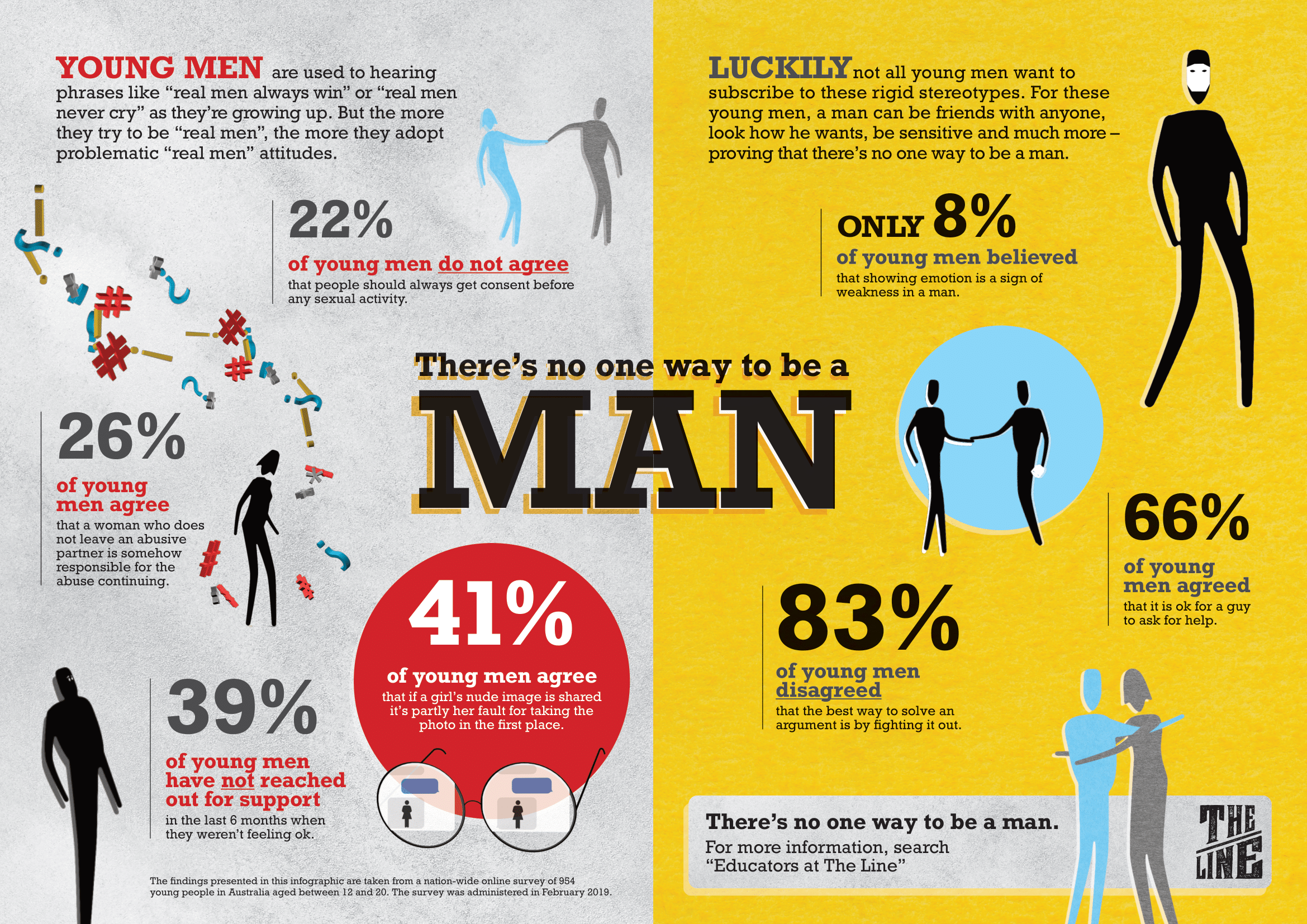Living up to the pressures of being a ‘real man’ can cause harm to young men and those around them.
By getting rid of the ‘rules’ about who can have what qualities, people of all genders can be free to be themselves, and be respected for who they are.
What pressure to ‘be a man’ looks like
Many young men grow up feeling pressured to conform to narrow expectations about what being a man means. These include the belief that ‘real men’ need to be autonomous, dominant and in control, aggressive and tough, risk-takers, stoic, hypersexual, heterosexual and suppress their emotions. This rigid set of ideas has been called the ‘Man Box’ by some researchers.
Many young men agree that they experience social pressure to behave or act a certain way because of their gender. A recent Australian study found that:
- almost half of young men (47%) think that guys should act strong even if they feel scared or nervous inside.¹
- almost half of young men (47%) have perpetrated physical bullying in the past month.²
- almost half (46%) of young men had made sexual comments to women they didn’t know in a public place in the past month.³
- more than half of young men (57%) went along or didn’t take action when witnessing guys making sexist comments or jokes.⁴
These messages and ideas about masculinity are communicated from birth and across boys’ and men’s lifetimes.
Impacts of the need to ‘be a man’
Living up to the pressures of being a ‘real man’ causes harm to young men and those around them, particularly women.
Young men who most strongly agree with the rules about being a ‘real man’ report poorer mental health and are more likely to engage in risky drinking and be in car accidents. These norms can influence the ways in which men relate to each other, and can be seen in the way some men and boys use homophobia, aggression and even violence to assert their masculinity, ‘prove’ their manhood and gain approval from male peers.
These dominant forms of masculinity also help to maintain gender inequality. They create and give legitimacy to the privilege and power that men as a group hold over women as a group, and that men hold in their personal relationships with women. Men who have a rigid attachment to these ‘norms of masculinity’ are more likely to demonstrate sexist attitudes and behaviours, and use violence against women — especially when their masculinity is challenged or when they find it difficult to live up to these norms.
What can you do?
You can inspire young people, especially young men, to reflect on the social pressures they face because of their gender and help them to navigate the limitations imposed on them.
- Use gender transformative strategies: This involves encouraging young men to critically reflect on and question dominant norms and practices of masculinity, and promoting more positive and respectful alternatives. The Never Follow campaign, that shows that there is no one way to “be a man”, is an example of this.
- Build awareness, knowledge and skills: Aim to increase young men’s awareness of the problems of gender inequality and violence against women. Build their knowledge about how they can actively help increase gender equality and prevent violence against women, and give them the skills to do so.
- Use direct participation: Education-based programs and initiatives are often more effective when they are participatory and encourage reflection and action. Consider this “Challenging the pressure to ‘man up’” activity as a place to start.
- Appeal to men’s emotional levers: Initiatives that build young men’s empathy for girls and women make them less likely to engage in aggressive or disrespectful behaviour towards women. Care should be taken to avoid inadvertently devaluing women or reinforcing the idea that women need to be protected by men.
- Use positive messaging: Instead of provoking shame, fear and humiliation, which are less effective, focus on men as part of the solution and on what men can do, rather than what they should not do.
- Use male role models and ambassadors: Promoting positive male peer relations is integral to efforts to engage men and boys. Men who measure themselves in relation to other men are also likely to be influenced by their peers, suggesting male role models can play a powerful part in promoting alternative, healthier patterns of masculinity.
- Engage women as well: While efforts that engage men on issues of masculinity are critical, there is also value in developing initiatives that engage women on this issue. Such engagement can increase awareness and critical reflection by women on the roles women sometimes play in supporting harmful ideas about masculinity.⁵
There are already promising signs. Many young men are already questioning the messages they receive about being a man. Well-designed initiatives that effectively engage men and boys to reflect on and challenge what it means to ‘be a man’ can contribute to the prevention of violence against women.

[Download this image here]
For more on addressing the pressure to man up, see:
- Men in focus: unpacking masculinities and engaging men in the prevention of violence against women
- The Man Box: A Study on Being a Young Man in Australia
Read next: Challenging the pressure to ‘man-up’
References:
¹ ² ³ ⁴ The Men’s Project & Flood, M, (2018) The Man Box: A Study on Being a Young Man in Australia. Jesuit Social Services: Melbourne.
⁵ Our Watch (2019) Men in focus: unpacking masculinities and engaging men in the prevention of violence against women. Summary of the Evidence Review, Our Watch: Melbourne.




